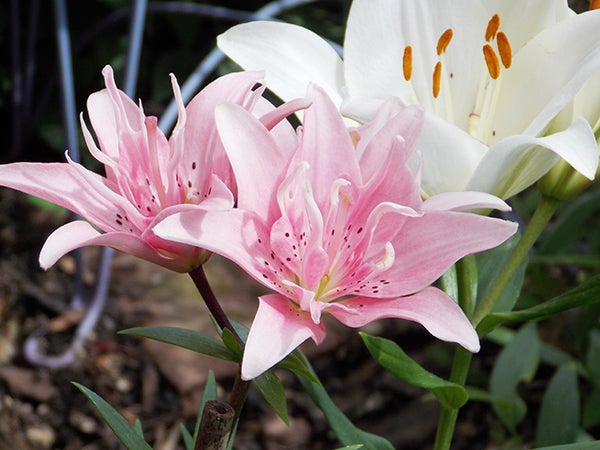The benefits of lilies being in your gardens
Published 9:00 am Sunday, April 10, 2016

These two varieties of lilies bloom in early August, adding color and fragrance. – Carol Hegel Lang/Albert Lea Tribune
Serendipity Gardens by Carol Lang
There are some plants and shrubs that are so hardy that even a novice gardener can have a beautiful garden. Do you remember as a child driving the country roads and you would see orange daylilies blooming everywhere? Those are what are known as orange ditch daylilies. Many consider them not very pretty and rather ordinary, but what I like about them is they are early bloomers compared to the rest of my daylilies, and they bloom for a long time.
One of the best things about daylilies is that they are almost indestructible and withstand our harsh winters with no protection. Over the years I have added many that were in friends’ gardens. They are so easy to divide and can be transplanted almost any time during the season without harm. One year I dug some out to transplant to another area. I accidently left a small clump of them and didn’t find them until the following spring, yet, believe it or not, they were sprouting.
There are so many types of daylilies that bloom from early June to August in my gardens. Some of them are repeat bloomers and this is what I have been adding to my own gardens the past couple years. Blooms on daylilies range from about three inches with the minis to nearly nine inches. Some of the more exotic ones are called spiders that have petals that recurve at the tips. Doubles are fairly common now, and I have several of them. I really love them. Daylilies typically have 22 chromosomes in the nucleus these are called diploids. Tetraploid daylilies have 44 chromosomes and tend to have more substance to them with thicker leaves and flowers and stronger flowerscape and more intense coloration. Daylilies come in a huge selection of color combinations. Plant them in full sun.
Next on my list of hardy perennials would be hosta — probably the most recognized shade plant and another that is very difficult to not have success growing. Over the years we have seen many new varieties in color, leaf shape and size so that there is a hosta for any size garden. One of the newer varieties, curly fries have narrow, arching chartreuse leaves with wiggly ruffles. It is not the hosta your mother or grandmother had in her shade garden. Dancing queen is a very pale yellow color with a piecrust edge. It will really brighten a dark corner. Now if you want a hosta that makes a statement empress wu is the largest variety available forming a clump three to four feet wide and tall with thick, deeply veined, slug-resistant leaves. Dividing them every few years will give you more to plant in your gardens.
If you want to add some excitement with color add lilies to the gardens. There are trumpet that grow very tall, 4 to 6 feet; orienpets, 3 to 4 feet; Turkish cap. like tiger lilies; double flowering; Asiatic, not fragrant; L.A. hybrids, similar to Easter lilies; and orientals. The color combinations are gorgeous with many with spots on them. Some have different colors on the outer edges while some are very fragrant. These can be purchased in pots or as bulbs. The past couple of years I have started adding more of each group and especially love the different colors of tigers now available. Blooms range from early to late summer.
In spring we have the bulbs we planted late fall with tulips, daffodils, crocuses and alliums that add color to gardens when little else is blooming. Bleeding hearts come in colors of pink, red and white and the little lockets are lovely. Mine give me many babies under them to transplant in other areas to add more of these adorable gems.
Hydrangeas are really a four-season shrub that come in a variety of sizes that will fit most any size garden. They are also available in a tree-form that will add height. The past couple of years I have added the smaller ones and have even planted them in large containers that have done very well over the winter. Leaving the flower heads on will add something visual in the winter garden. They are very hardy if you plant ones for Zone 4 so make sure you check the tag on them. In my own gardens I have paniculata, oak leaf, which is in Zone 5, and several others adding wonderful textures.
“The color of springtime is in the flowers; the color of winter is in the imagination.” — Terri Guillemets
Carol Hegel Lang is a green thumb residing in Albert Lea. Her column appears weekly. Email her at carolhegellang@gmail.com.


